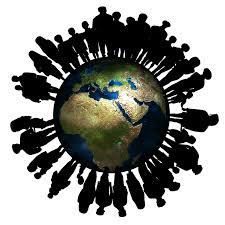Introduction And Drug Abuse
Socially significant disease Firstly, what is disease ? This is in simple language and lacks ease.If we go to the definition of health by WHO,it says,” Health is a complete state of...

Human population
Definition :
It is referred to as a group of individuals belonging to the same species occupying a certain area at a certain time.
The study of this is termed Demography.
Population dynamics: It is the scientific study of changes in features of a population.
Characteristic features of population:
1.Population density: for a population, we can get density by simply dividing the number of people by the area they are residing in.
This will give the idea of the total individual per unit area.
2. Natality: for a population, we can have a rate at which individuals are born per unit time called natality.
Natality = (number of individuals born/ crude population ) / 1000
This will let us know how many individuals were born per 1000 individuals.
3. Mortality: no individuals of any population can perish till eternity. They will die sooner or later. So, this is also a characteristic phenomenon for the population.
So, it can be calculated as below.
Mortality = (number of deaths / crude population) 1000
This provides us with a death rate per 1000 individuals.
Moreover
4. Immigration: the arrival of individuals into a population for permanent settlement.
This leads to a rise in population.
5. Emigration: the outward movement of the individuals from the native place.
These features also influence population density.
Interrelation of population density with it’s influencing factors.

6. Crude population density. This is average number of people per unit area.
7. Population explosion: population may grow rapidly and unplanned causing this.
8. Sex ratio: the population is majorly divided into two genders; male and female. so, the population can have a ratio of two major genders.
9. Age ratio: population possesses individuals of various ages.
10. Maximum carrying capacity : this is capacity of a certain area to support the maximum number of species throughout the population.
11. Biotic potential: this is the physiological capacity of the organisms to produce offspring. this is influenced by environmental factors like food availability, infectious disease.
Population growth
The growth rate of any population of a particular place can be based on the count of decrease, increase or remain constant number at a given time.
Population growth rate (PGR) =( ( B-D-E)/ P) K
Population growth curves :
The graph is plotted in-between time on Xaxis and number of population on
Y-axis to give population curves.
They are of 2 types :
J shaped
S-shaped
They differ as follows :
| J Shaped curve | S-shaped curve |
| 1.This curve has two phases; lag and exponential phase. | 1. This curve has 3 phases: lag, exponential and stationary phase |
| 2. it is also referred to as an exponential curve. | 2. It is also referred to as a logistic curve. |
3. | 3. |
Malthus theory of human population :
This theory is based on the following facts :
Unchecked population grows geometrically but means of subsistence like food, shelter grows only arithmetically.
The rapid growth of the population creates imbalances in the environment.
The imbalance causes malnutrition, hunger, the spread of disease, droughts, famines, and war.
Factors affecting population :
Natality
Mortality
Immigration
Emigration
Environment factors
Causes of population growth :
Advancement in medical science along with the discovery of antibiotics and surgery.
Lack of awareness about family planning, birth spacing.
Early marriage
Polygamy and poly conception for son.
Lack of implementation of Laws regarding control in a population explosion.
Consequences of population growth
Unemployment
Poverty with famine and malnutrition.
Illiteracy
Deforestation and ecological imbalance.
Spread of disease
Lack of sustainable development.
Increase in criminal acts.
Control measures :
Awareness about family planning and birth spacing.
Abortion must be legalized.
Relevant laws must be made and implemented regarding population growth.
Birth control is the most effective way of population control.
Birth control can be explained as follows :
Natural methods
Safe period :
Coitus must e done calculating safe period if you are not opting for the child.
This can be tentatively calculated by subtracting10 from the longest cycle and 18 from the longest cycle.
b.Withdrawal method
This is withdrawing penis out of vagina just before ejaculation to prevent insemination.
This method is frustrating as ejaculation time is the time of plateau .
So escape chance is just around 30%.
c.Abstinence
It is refraining from sexual intercourse and rather masturbating.
Mechanical methods
Physical barrier method
Condoms for men and diaphragm for women is used as a barrier during coitus to prevent any chance of insemination.
Chemical methods
Potassium permanganate, zinc sulphate, lactic acid are used to prevent conception. In Nepal, Kamal chakki is a famous chemical for this.
Hormonal methods
Derivatives of estrogen and progesterone are used to trick the hypothalamus so that it stops FSH and LSH secretion; which stops ovulation and eventually pregnancy.
Surgical methods
Vasectomy : surgical cut of vas deferences; and stichings each end to prevent sperm in ejaculated semen.
Tubectomy : surgical cut of fallopian tube to prevent any ova to fuse with incoming sperm.
This surgical method is permanent and will leave you rest of your life incapable to make a child.
6. IUCD (Intra Uterine contraceptive devices ) like Copper T In the uterus. but this is less used d due to medical complications.Even this is a permanent control method.
